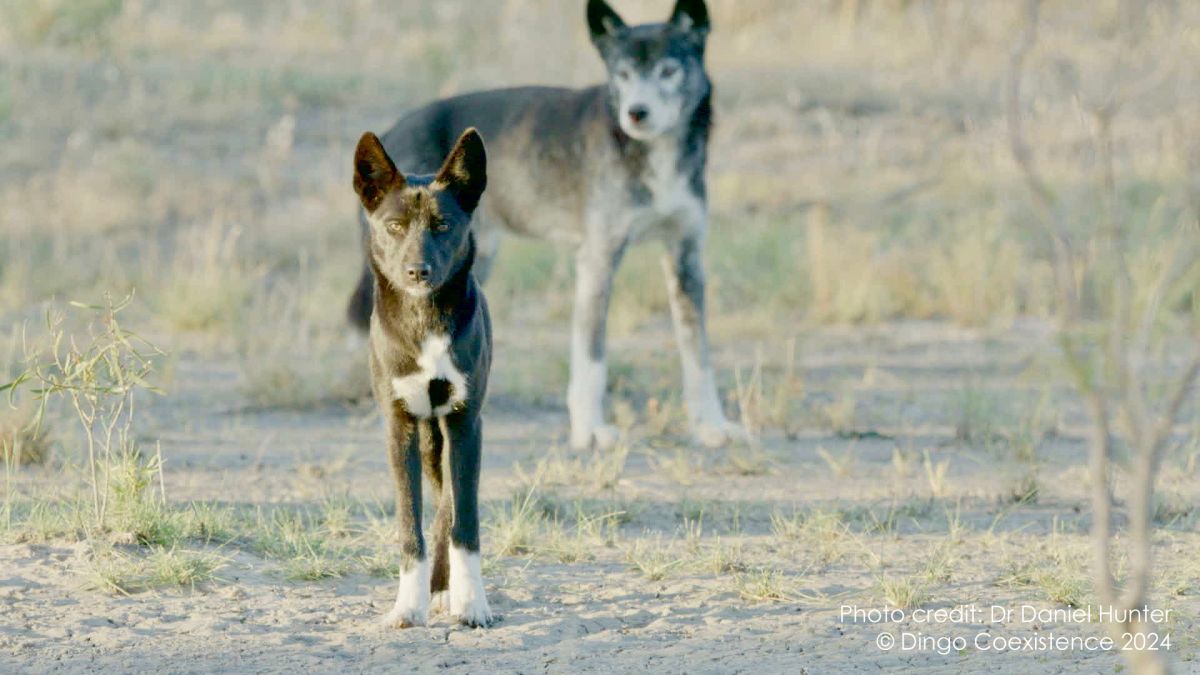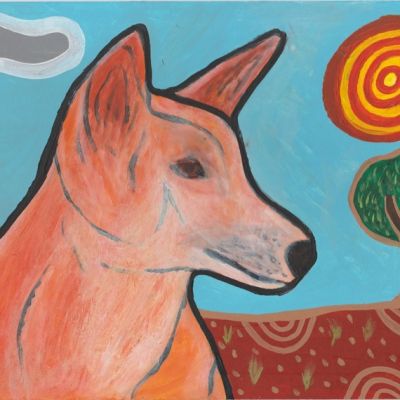
Mallee Dingo in the Big Desert National Park. Credit: Dr Daniel Hunter
Dingoes in Victoria
In Victoria, Dingoes (Canis lupus dingo) are protected threatened wildlife under the Wildlife Act 1975 and listed as ‘Vulnerable’ on the Flora and Fauna Guarantee Act 1988 Threatened List.
Where can dingoes be found in Victoria?
Across Australia, the dingo occupies a wide variety of environments from arid grasslands to wet forests and alpine snowfields.
Historically, the dingo likely occupied most habitats throughout Victoria. Today however, dingoes only occur in dry and wet forest, sub-alpine woodland, coastal heath in eastern Victoria and scrub and mallee woodland in north-western Victoria.
Victorian dingoes are restricted to landscapes with extensive public land, such as the Big Desert in the northwest and the forests of eastern Victoria. These two areas are geographically isolated and ecologically distinct and represent two Victorian dingo subpopulations:
- a small and isolated north-western subpopulation; and
- a larger and broadly distributed eastern subpopulation.

Credit: Brendan Kennedy
Cultural importance
Dingo is a significant cultural species for Victoria’s First Peoples and is often described as a totemic species, kin and family.
The dingo is interwoven in the Dreamtime and Creation Stories and ‘inscribed in the landscape’ in cultural landforms and rock art. The dingo features prominently in the storylines and songlines of Victorian Traditional Owners which connect peoples to dingo across Nations in Victoria.
The dingo is vital for maintaining Traditional Owner connection to Culture, including the use of language, ceremony, lore and customs and to Country.
Dingo has many names in Indigenous Australian culture, dependent on language and Country including the following Indigenous Language names for dingo in Victoria: Bandiyl, Wilkerr, Darrwal, Gal Gal, Gali, Kali, Yirrangan, Wilga, Wirrangan, and Ngeining.
Ecological importance
Dingoes are Victoria’s largest native apex species. The dingo is a highly adaptable carnivore, with a flexible diet. Primary food sources include wombats, kangaroos and wallabies. Dingoes will also consume birds, reptiles, fruits, and insects.
Dingoes are known to impact on livestock, especially sheep.
Dingoes form social packs of 3-12 individuals. Pack size varies with population density, food availability, and territory availability. Dingoes are typically highly territorial, and only the dominant, or alpha, female, breeds.
Dingoes typically weigh 13-24 kg, with males generally heavier than females. They stand about 52-63 cm tall and have a variety of coat colours. Dingoes have a lean body, pricked ears, and a bushy tail.

Dingo pack captured on trail camera in central eastern Victoria. Source: Melbourne Water
New scientific research on dingo genetics and populations in Victoria
Dingoes are genetically distinct
Recent scientific research using contemporary genetic techniques and appropriate genetic markers (Weeks et al 2024, Cairns et al 2023) has fundamentally changed our understanding about dingo populations in Victoria.
The research compares the use of these contemporary techniques with previous methodology to demonstrate more powerful results that have allowed researchers to better understand patterns of genetic structure, genetic health and assess gene flow or hybridisation between populations.
Both studies show that in Victoria there is limited evidence of hybridisation (interbreeding) between domestic dogs and dingoes. This means most animals we previously thought were wild dogs, are in fact, dingoes.
Genetic research
In 2023, a UNSW-led scientific study showed dingo hybridisation with domestic dogs is rare and that dingoes are genetically distinct from domestic dogs.
The study suggested that previous dingo assessments severely overestimated the degree of dingo hybridisation with dogs, particularly in south-eastern Australia. In other words, most animals previously thought to be wild dogs are likely to be dingoes.
The published research also indicates that the dingo subpopulation in north-west Victoria is a distinct subpopulation with low genetic diversity that is experiencing inbreeding due to its numbers dropping.
Further reading:
DEECA commissioned independent peer-reviewed research to provide critical information on Victoria’s dingo population size, structure, and distribution using contemporary genetic techniques and appropriate genetic markers. This research conducted by CESAR Australia (affiliated with University of Melbourne) was published in 2024.
The CESAR research found no evidence of hybridisation between dingoes and domestic dogs and that previous work has likely mischaracterised shared ancestral genetic variation as evidence for hybridisation. The authors suggest that social structure and dingo behaviour are significant barriers preventing hybridisation with domestic dogs in Australia.
The Australian dingo has undergone over 5,000 years of independent evolution without the presence of another canid in Australia, creating a unique lineage that is different from other canids that is on an early pathway towards speciation. The New Guinea Singing Dogs are the only canid group to share significant ancestry with dingoes.
The research identified 2 subpopulations of dingo in Victoria:
- the Mallee population in the north-west; and
- the Alpine population in the state’s East.
The research further builds on our understanding that indicates that the Mallee dingo population is very small, completely isolated, and at significant threat of local extinction.
Population estimates
In January 2024, the DEECA's Arthur Rylah Institute (ARI) calculated estimates for the Victorian dingo population using existing data from camera traps.
This work concluded the following dingo population estimates:
- for eastern Victoria, the total dingo population was within the range 2,640 to 8,800; and
- for north west Victoria, the total dingo population was within the range between 40 and 230.
In April 2024, a series of scientific workshops were held to further refine the dingo population estimates and test the information available against the international criteria for conservation status assessments.
Additional field data and genetic analysis was used to estimate the ‘number of individuals capable of breeding’ rather than the total dingo population. The number of individuals capable of breeding is the relevant population for consideration under the international criteria for conservation status assessments and is estimated as follows:
- for eastern Victoria, the estimated population is 2940 (within the range of 1584 to 5280); and
- for north-west Victoria, the estimated population is 16 (within the range of 12 to 20).
Population estimates show that the dingo population in the north-west of the state is at risk of extinction if threats to the population are not addressed. Population estimates are essential for species management and conservation. Understanding the population size of a species that lives in large areas and avoids humans can be difficult.
While these recent population assessments and the latest genetic research has added to our understanding of dingo genetics and populations in Victoria, we are continuing to work to build our understanding of dingoes in Victoria, including further investment in population assessments.
Further reading:
This report is a summary of data compiled by DEECA’s Arthur Rylah Institute and includes information relating to dingo abundance and livestock predation. Following the identification of a reporting issue associated with the data contained in this report, it was updated in October 2024 and additional information provided in footnotes throughout.
Conservation Status Assessment for dingoes in Victoria

Mallee dingo, captured on trail camera in north-west Victoria. Source: Deakin University
In response to the latest genetic research and population data on Victorian dingoes, the Victorian Government has completed a comprehensive review of the species’ conservation status in Victoria.
Scientists previously believed that hybridisation – crossbreeding with domestic dogs - was the greatest threat to the dingo in Victoria. In light of the latest DNA findings that hybridisation in the wild is rare, a new assessment of the species’ conservation status was required.
DEECA engaged with 15 experts from across Australia in dingo and apex predator ecology, dingo genetics, and the conservation status assessment process to collate relevant scientific information and apply the information to the assessment criteria.
The 2024 assessment considered all available information to determine whether an amendment to the conservation category was required, including delisting if the species was no longer deemed threatened in Victoria under the Flora and Fauna Guarantee Act 1988.
The 2024 assessment supports retaining dingoes on the Flora and Fauna Guarantee Act 1988 Threatened List as ‘Vulnerable in Victoria’.
DEECA applied the Common Assessment Method – a consistent approach to the assessment and listing of threatened species across Australian jurisdictions.
The Common Assessment Method is based on the best practice standard developed by the International Union for Conservation of Nature (IUCN). Guidelines, training, and specialist groups support the consistent application of the process.
Dingo management
The Victorian Government acknowledges that livestock predation is a significant challenge for Victorian farmers, and the Government has undertaken a comprehensive assessment of Victoria's dingo population to guide management practices that most appropriately balance the protection of livestock and the conservation of dingoes.
Order in Council unprotecting the dingo in certain circumstances
From 25 September 2024, the dingo unprotection Order was remade in eastern Victoria and will have effect until 1 January 2028.
The new dingo unprotection Order allows the lethal control of dingoes for the protection of livestock on private land and within a 3km buffer zone along the boundaries of public land in eastern Victoria. The dingo unprotection Order no longer applies outside of eastern Victoria.
The new Order excludes north-west Victoria due to the risk of extinction of its local dingo population.
Page last updated: 18/06/25